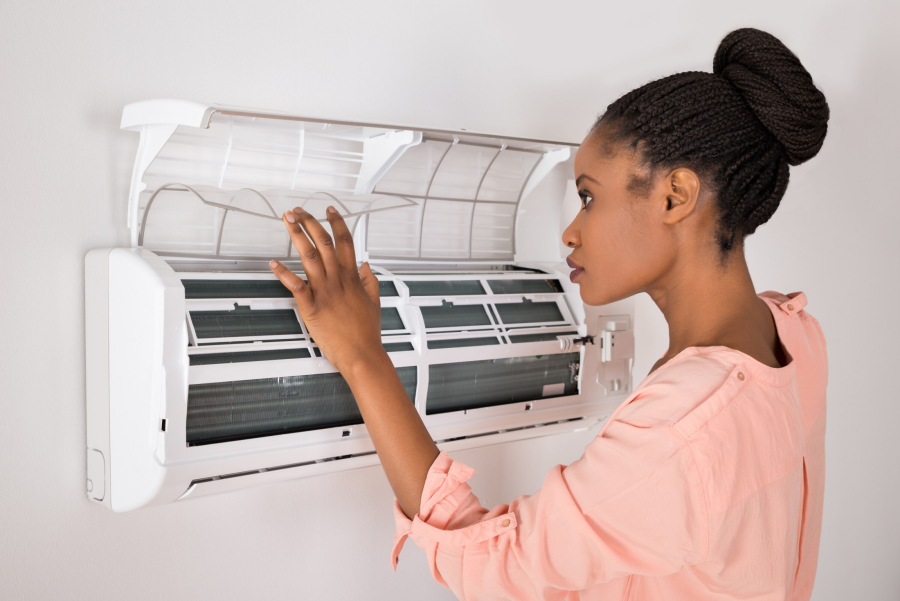
As the seasons change and temperatures fluctuate, the way we cool our homes has evolved significantly. From simple fan systems to complex central air solutions, each step in the development of home cooling technology has aimed to increase comfort and efficiency. Among these, ducted air conditioning systems have long been a staple in Canadian homes, prized for their ability to deliver centralized cooling.
However, as technology advances and environmental awareness grows, the limitations of ducted air conditioning are becoming more apparent, leading many to seek more sustainable and efficient alternatives.
What Is Ducted Air Conditioning?
Ducted air conditioning systems, often referred to as central air, operate by distributing cooled air through a series of ducts concealed within the walls, floors, or ceilings of a home. At the heart of this system is a central unit that cools the air, which is then pushed through the network of ducts and released into various rooms via vents. This method allows for a uniform temperature across different sections of the house, making it a popular choice for comprehensive home cooling.
In Canada, ducted air conditioning has been traditionally favoured for several reasons. The ability to cool an entire home from one centralized system is particularly appealing in regions experiencing varied climate conditions. Moreover, these systems have been integrated into residential construction practices, often installed during the building phase of new homes. This integration is driven by the desire for a seamless look that doesn't disrupt the aesthetic of the home's interior.
However, despite their widespread use and integration into Canadian homes, ducted systems are facing increased scrutiny. Concerns over energy efficiency, cost-effectiveness, and overall environmental impact are leading homeowners to consider alternatives that better meet the modern standards of sustainable living.
The Drawbacks of Ducted Air Conditioning
While ducted air conditioning systems have been a popular choice for decades, several inherent drawbacks are prompting homeowners to reconsider their cooling solutions. These challenges range from inefficiency and high energy consumption to the physical constraints and cost issues associated with installing and maintaining these systems.
Inefficiency and Energy Consumption
One of the primary concerns with ducted air conditioning systems is their energy efficiency. These systems can lose significant amounts of energy due to heat exchange in the ductwork, especially if the ducts are not well-insulated or if they pass through unconditioned spaces like attics or crawl spaces.
According to some estimates, duct losses can account for more than 30% of energy consumption, especially if the ducts are leaky or poorly routed. This inefficiency not only leads to higher utility bills but also increases the carbon footprint of a home, contradicting the growing demand for more environmentally sustainable practices.
Space and Aesthetic Limitations
Ducted systems also require substantial space for installation, which can be a significant limitation in homes with limited architectural flexibility.
The ductwork needs to be routed through ceilings, walls, and floors, which can restrict design options and impact the overall aesthetics of a home. For older homes or those with unique architectural features, integrating ductwork can be particularly challenging without compromising the integrity and appearance of the building structure.
Cost Implications
The financial aspect of ducted air conditioning systems is another significant concern. The initial installation cost can be quite high, particularly if the home does not have existing ductwork.
Retrofitting ductwork into an existing structure can be invasive and expensive. Furthermore, maintenance costs for ducted systems can add up over time. Regular cleaning, repair of leaks in ducts, and energy inefficiency all contribute to ongoing expenses. These cost factors make ducted systems less appealing, especially when compared to newer technologies that are both more cost-effective and energy-efficient.
Why Homeowners Are Switching to Ductless Systems
The transition away from traditional ducted air conditioning to ductless systems is driven by several compelling advantages. Ductless or mini-split systems are gaining popularity among Canadian homeowners due to their energy efficiency, customizable cooling options, and their contribution to improved indoor air quality and quiet operation.
Enhanced Energy Efficiency
Ductless systems are renowned for their superior energy efficiency. Unlike ducted systems, which can lose significant energy due to heat exchange in the ductwork, ductless systems deliver air directly into each room, minimizing energy losses.
This direct approach allows for greater operational efficiency, as each unit can be controlled independently, ensuring that energy is not wasted cooling unoccupied spaces.
Many ductless systems use advanced inverter technology, which can significantly reduce power consumption by adjusting the speed of the compressor to the demand for cooling. This not only lowers energy bills but also aligns with the environmental values of reducing one's carbon footprint.
Flexibility and Customizable Cooling
One of the standout features of ductless systems is their flexibility. Each indoor unit can be controlled independently, allowing for room-by-room temperature control. This is particularly advantageous in houses where room usage varies significantly; for example, unoccupied rooms can be kept at different temperatures, or areas that heat up due to sunlight exposure can be specifically targeted for cooling.
Because they do not require ductwork, mini-split systems can be installed in a variety of locations, making them ideal for older homes, new additions, or buildings where conventional ducting is impractical.
Improved Air Quality and Quiet Operation
Ductless systems also offer benefits in terms of indoor air quality and noise levels. Since there are no ducts to collect dust, allergens, and other air pollutants, these systems typically provide a cleaner air flow.
Many ductless models come equipped with multi-stage filtration systems that further reduce dust, bacteria, pollen, allergens, and other particulates in the air. Moreover, ductless air conditioners are known for their quiet operation. The major components that generate noise are located in the outdoor unit, significantly reducing the indoor noise level, which enhances comfort within the home.
The Environmental Impact of Switching to Ductless
As environmental consciousness continues to shape homeowners' decisions, ductless air conditioning systems stand out for their ability to significantly reduce the carbon footprint of residential cooling. This aligns closely with the priorities of modern Canadian homeowners who are increasingly committed to sustainable living practices.
Ductless systems operate with greater energy efficiency compared to traditional ducted systems. By minimizing energy losses that are typically associated with ductwork, these systems require less power to cool the same amount of space. This reduction in energy consumption directly translates into lower greenhouse gas emissions, as less energy production means fewer emissions.
Furthermore, many ductless systems use refrigerants that have a lower global warming potential (GWP), which further reduces their environmental impact.
Another key environmental benefit of ductless systems is their scalability. Unlike a centralized system that cools entire homes regardless of the need, ductless systems can be tailored to cool only occupied spaces. This targeted approach not only conserves energy but also prevents the overuse of resources, which is crucial for sustainable energy management. Homeowners can install single units in specific areas, or multiple units throughout their homes, depending on their specific cooling needs, without the burden of cooling unnecessary spaces.
The adaptability of ductless systems also plays a significant role in preserving the structural integrity and insulation of homes. Since there is no need to install extensive ductwork, homes can maintain better thermal insulation, reducing heat loss in winter and heat gains in summer. This contributes to overall energy conservation, making homes more energy-efficient year-round.
What to Consider Before Upgrading
Upgrading to a ductless air conditioning system is a significant decision that involves careful consideration of your home's specific needs and circumstances. Ensuring that you choose the right system and model for your home can lead to better efficiency, comfort, and long-term satisfaction. Here are key aspects to consider when planning an upgrade to a ductless system.
Assessing Your Home’s Needs
Before deciding on a ductless air conditioning system, it's crucial to perform a thorough analysis of your home’s cooling requirements. This process should start with a heat-load calculation, which takes into account various factors such as the size of your home, the number of windows and their orientations, insulation quality, and even the number of occupants. This calculation will help determine the capacity of the cooling system needed to efficiently and effectively manage the climate in your home.
Also consider the layout of your home. Ductless systems are versatile, allowing for targeted cooling in specific areas or rooms. Think about which rooms are used most frequently and might benefit from individual temperature control. This targeted approach not only maximizes comfort but also enhances energy efficiency by cooling only the spaces that are in use.
Choosing the Right Model
Once you have a clear understanding of your needs, selecting the right model of ductless heat pump system is the next step. There are several factors to consider:
-
Energy Efficiency: Look for models with high SEER (Seasonal Energy Efficiency Ratio) and HSPF (Heating Seasonal Performance Factor) ratings. Higher ratings indicate more energy-efficient units, which can significantly reduce electricity consumption and lower your utility bills.
-
Features: Consider models that offer additional features such as programmable timers, remote controls, and smart thermostats that can be integrated with home automation systems. These features enhance convenience and further improve energy management.
-
Brand and Warranty: Opt for reputable brands known for reliability and quality. Check the warranty terms to ensure that you have ample coverage for your new system, as this can provide peace of mind and protect your investment.
-
Professional Installation: It's also crucial to choose a certified and experienced installer. Proper installation is key to ensuring that the system operates efficiently and lasts for many years. An experienced professional will also help ensure that the unit is correctly sized and optimally placed to deliver the best cooling performance.
By carefully assessing your home's specific needs and choosing the right model, you can maximize the benefits of a ductless air conditioning system. This not only ensures enhanced comfort and efficiency but also contributes to the overall sustainability of your home environment.
Embracing the Future of Home Cooling
The shift from ducted to ductless air conditioning systems represents a significant advancement in the way we cool our homes. This transition offers numerous benefits that align with the needs and values of modern homeowners, particularly those concerned with energy efficiency, environmental impact, and cost-effectiveness.
Ductless systems provide superior energy efficiency by eliminating the losses associated with ductwork and enabling precise temperature control in individual rooms or zones. This not only reduces energy consumption but also decreases the carbon footprint of home cooling practices. The flexibility of installation and the ability to customize cooling settings further enhance the appeal of ductless systems, making them a practical solution for any home layout, including older homes or those with unique architectural features.
The improved air quality and quiet operation of ductless systems contribute to a more comfortable and healthier living environment. When considering the long-term benefits, ductless systems are not just an alternative to traditional ducted air conditioning but a substantial upgrade that offers significant savings on energy bills and maintenance costs.
As we look towards creating more sustainable and efficient homes, considering the adoption of ductless air conditioning systems becomes increasingly important. For homeowners planning to upgrade or install new cooling systems, evaluating the advantages of going ductless is certainly worthwhile.
Ready to experience the benefits of a ductless air conditioning system in your home? Contact The Boiler Shoppe for a personalized quote and expert evaluation. Our team of qualified professionals is dedicated to helping you find the perfect cooling solution tailored to your needs.
